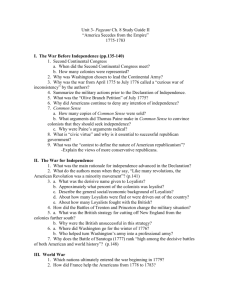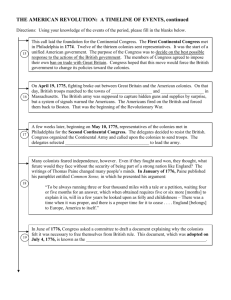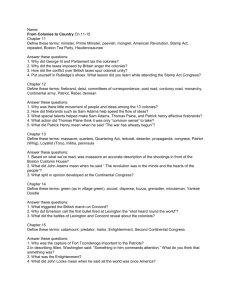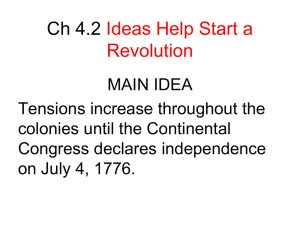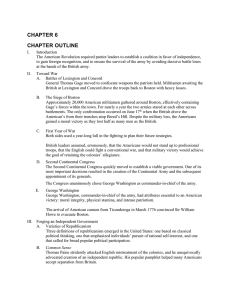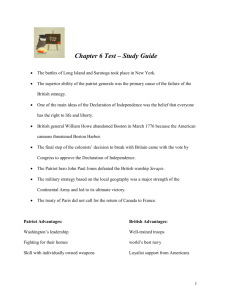Chapter 6: The American Revolution
advertisement
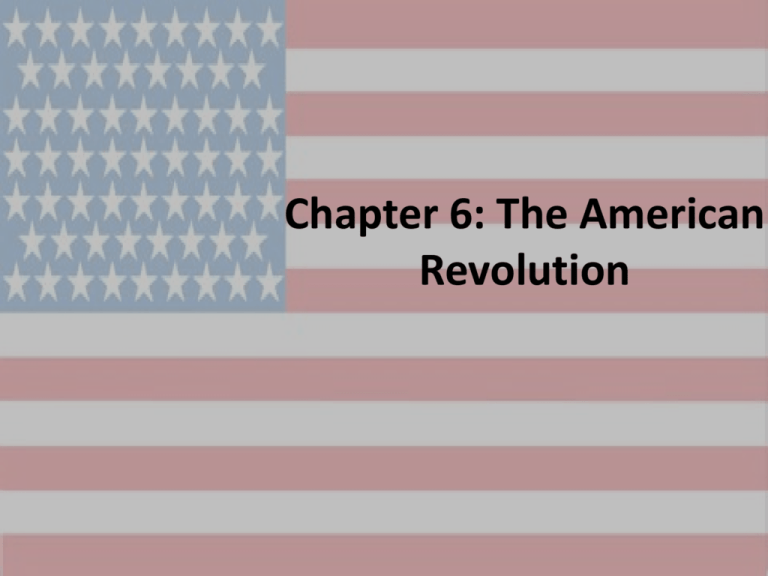
Chapter 6: The American Revolution I. Introduction • The American Revolution required patriot leaders to establish a coalition in favor of independence, to gain foreign recognition, and to ensure the survival of the army by avoiding decisive battle loses at the hands of the British army. II. Government by Congress and Committee A. First Continental Congress • The Congress had to define its grievances and define a plan of resistance. A third goal—outlining constitutional relations with England—proved more troublesome. • The Congress accepted the Declaration of Rights and Grievances, which declared that the colonies would obey bona fide acts of Parliament and would resist taxes in disguise. B. Continental Association • The Congress also adopted the Continental Association, which called for nonimportation of British goods, nonconsumption of British products, and nonexportation of American goods to Britain and the British West Indies. C. Committees of Observation • Congress called for the creation of committees of observation and inspection to enforce its economic proposals. These committees became de facto governments and developed elaborate spy networks to identify opponents of American resistance. D. Provincial Conventions • By the early spring of 1775, many colonial governments were collapsing in the face of patriot challenges to their authority. Popularly elected provincial conventions took over the task of governing in most colonies. III. Contest in the Backcountry A. Distrust and Warfare • Land-hungry colonists swarmed onto the lands along the Ohio River and its tributaries after the mid-1760s. • “Lord Dunmore’s War” occurred in 1774 as Virginia attempted to assert its title to the backcountry in Kentucky, on the south side of the Ohio River. • Both the British and the Americans sought to maintain Indian neutrality rather than active participation in the war. B. Frontier Hostilities • Some Shawnee and Cherokee tribes attacked settlements, but the Indians suffered defeat. IV. Choosing Sides A. Nova Scotia and the Caribbean • Nova Scotia and the British West Indies had economic reasons for supporting the British. B. Patriots • Those who became active revolutionaries constituted about forty percent of the population and came primarily from those who had dominated colonial society. C. Loyalists • About twenty percent of Americans recognized dangers in resistance and remained loyal to England. One thing that loyalists had in common was their opposition to men who became patriot leaders. D. Neutrals • Another forty percent chose to be neutral and, along with loyalists, suffered persecution at the hands of the patriots. E. African Americans • Colonies with the highest percentages of African Americans expressed the lowest support for the revolution. • Slaves generally sought to escape their bondage by supporting the English. Lord Dunmore’s Proclamation offered freedom to slaves and indentured servants who left their patriot masters and joined the British forces. • How did the Second Continental Congress react to Dunmore’s Proclamation? They allowed African Americans to enlist in the Continental Army V. War and Independence A. Battles of Lexington and Concord • General Thomas Gage moved to confiscate weapons the patriots held. Militiamen awaiting the British at Lexington and Concord drove the troops back to Boston with heavy losses. B. First Year of War • Both sides used a year-long lull in the fighting to plan their future strategies. C. British Strategy • British leaders assumed, erroneously, that the Americans would not stand up to professional troops, that the English could fight a conventional war, and that military victory would achieve the goal of retaining the colonies’ allegiance. D. Second Continental Congress • The Second Continental Congress quickly moved to establish a viable government. One of its most important decisions resulted in the creation of the Continental Army and the subsequent appointment of its generals. • The Congress unanimously chose George Washington as commander-in-chief of the army. E. George Washington • George Washington, commander-in-chief of the army, had attributes essential to an American victory: moral integrity, physical stamina, and intense patriotism. F. British Evacuate Boston • The arrival of American cannon from Ticonderoga in March 1776 convinced Sir William Howe to evacuate Boston. G. Common Sense • Thomas Paine stridently attacked English mistreatment of the colonies, and he unequivocally advocated creation of an independent republic. His popular pamphlet helped many Americans accept separation from Britain. • Congress began debate on Richard Henry Lee’s resolution calling for independence from England and directed a fiveman committee to draft a declaration of independence. The committee assigned the task of writing the declaration to Thomas Jefferson. H. Jefferson and the Declaration of Independence • Congress approved Thomas Jefferson's Declaration of Independence, which contained a list of grievances against King George III and a stirring statement of American political ideals. • “Give me liberty, or give me death.” • “One of the strongest natural proofs of the folly of hereditary right in kings, is, that nature disapproves it, otherwise, she would not so frequently turn it into ridicule by giving mankind an ass for a lion.” • “Society in every state is a blessing, but government even in its best state is but a necessary evil; in its worst state an intolerable one; for when we suffer, or are exposed to the same miseries by a government, which we might expect in a country without government, our calamity is heightened by reflecting that we furnish the means by which we suffer...” ― Thomas Paine, Common Sense VI. The Struggle in the North A. New York and New Jersey • The Americans faced potential disaster in defending New York. Although Washington deserted the city, he managed to hold the core of the army together. • British plundering of New Jersey rallied many reluctant Americans to the patriot cause and convinced Washington to strike. Victories at Trenton and Princeton cheered American spirits as the army settled in for the winter. (Washington Crossing Map) B. Campaign of 1777 • General John Burgoyne planned a three-pronged invasion of New York that required close cooperation between all commanders but gave Burgoyne the glory. • Ignoring Burgoyne's plan and operating independently, Howe moved against Philadelphia in 1777, but logistical delays and American resistance prevented him from gaining any real advantage when he captured the city in September. • General John Burgoyne suffered a disastrous defeat in 1777. He hoped to divide the colonies by marching through New York, but he was forced to surrender with six thousand men near Saratoga on October 17. C. Iroquois Confederacy Splinters • The Battle of Oriskany on August 6, 1777, revealed a split in the three-hundred-year-old Iroquois Confederacy. Despite pledges of neutrality, several tribes supported the British; others fought for the Americans. D. Franco-American Alliance of 1778 • The victory at Saratoga led to French recognition of American independence, and a Treaty of Alliance brought France into the war in support of the new nation. VII. Life in the Army and on the Home Front A. Continental Army • The Continental Army was made up primarily of young, single, and propertyless men who signed up for long periods or for the duration of the war. The army also included immigrants and, after Lord Dunmore’s proclamation, Congress decided to allow the enlistment of African Americans. • Women worked as cooks, nurses, and launderers for which they received rations and low wages. B. Officer Corps • Officers developed a powerful sense of pride and commitment to their cause. C. Hardship and Disease • Life in the American army was difficult for everyone, but enlisted men suffered more hardships than officers. • Diseases often spread thorough the army. In 1777, Washington ordered that the entire regular army and all new recruits be inoculated for smallpox. D. Home Front • Women had to assume additional responsibilities to keep farms running during the war. • Americans had to endure shortages of necessities as well as severe inflation. VIII. Victory in the South A. South Carolina and the Caribbean • Charleston fell in May 1780, but the English never really established control over South Carolina, and they remained vulnerable to the French navy. After 1778, the French navy picked off British Caribbean islands one by one. B. Greene and the Southern Campaign • Nathanael Greene assumed command of American forces in South Carolina, and he instituted effective policies toward the British, loyalists, and Indians. C. Surrender at Yorktown • Lord Cornwallis led his troops into Virginia and encamped at Yorktown, where American and French operations forced him to surrender. • As a result of Cornwallis’s surrender at Yorktown, the North ministry fell from power and Parliament voted to cease offensive operations and to authorize peace negotiations. • Washington defused the “Newburgh Conspiracy” and at war’s end formally resigned his commission as commanderin-chief. As a result of such actions, Washington established the precedent of civilian control of the American military. • Over 25,000 American men lost their lives in the war, the South’s economy was shattered, and indebtedness soared. D. Treaty of Paris • The war ended with a treaty signed on September 3, 1783. England recognized American independence; accepted the Atlantic Ocean, the Mississippi River, Canada, and Florida as the American boundaries; and gave up fishing rights off of Newfoundland.



